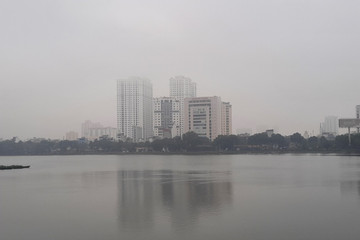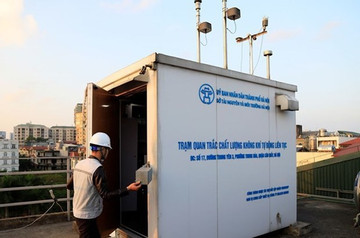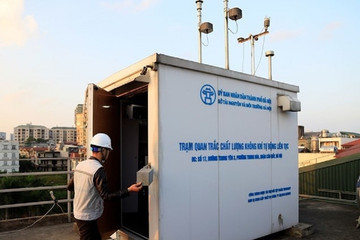- © Copyright of Vietnamnet Global.
- Tel: 024 3772 7988 Fax: (024) 37722734
- Email: evnn@vietnamnet.vn
air pollution
Update news air pollution
Sinusitis becoming more common among city residents
In the current environment filled with smoke, dust, and pollution, more and more people in major cities are contracting sinusitis.
Air pollution in Hanoi worsens in winter, fine dust levels exceed safe limits
Hanoi’s air pollution has reached dangerous levels, with PM2.5 and PM10 concentrations exceeding safe limits, posing significant health risks for residents.
How will Hanoi transition to low-emission zones?
Starting in 2025, Hanoi will trial low-emission zones in Ba Dinh and Hoan Kiem districts, raising questions about how residents and workers will adapt to stricter vehicle restrictions.
Ba Dinh and Hoan Kiem districts selected for Hanoi’s low-emission zone pilot
As part of a citywide pollution reduction effort, Hanoi will ban high-emission vehicles in selected districts and support residents in transitioning to clean energy transport.
Hanoi to limit polluting vehicles in pilot low-emission zones
Proposals for fees and charges for pollution-emitting vehicles travelling in low-emission zones are expected to be imposed too.
Thick haze covers Ho Chi Minh City as air pollution concerns mount
Ho Chi Minh City remains shrouded in dense haze caused by mixed fog, with experts warning of health risks from polluted air and fine particulate matter.
Toxic air in Hanoi slashes incomes, increases health risks
Fine particulate matter (PM2.5) pollution has consistently exceeded safety standards in Hà Nội and nearby provinces such as Bắc Ninh and Thái Nguyên since 2019.
Toxic air in Hanoi slashes incomes, increases health risks
Fine particulate matter (PM2.5) pollution has consistently exceeded safety standards in Hà Nội and nearby provinces such as Bắc Ninh and Thái Nguyên since 2019.
Millions of old, dilapidated motorbikes still in circulation on roads
Emissions from motorbikes and cars are one of six air pollution sources in Hanoi, discharging 70 percent of toxic gases to the environment. In large cities, millions of old motorbikes are still in traffic.
Hanoi requires comprehensive emission data
Experts have raised concerns over Hanoi’s rising air pollution, emphasising the need for comprehensive data and updates on emission sources to identify the causes and extent of the city’s air quality issues.
With 80.6 million vehicles on the roads, air pollution rate worsens
Vietnam has about 80.6 million vehicles, one of the biggest greenhouse gas emission sources that pollutes the air and contributes to climate change.
Air pollution in Hanoi is likely to persist until early next year
Air quality in Hanoi tends to worsen during the winter, experts said based on observations over the past several years.
HCM City blanketed in thick fog, air pollution rises as fine dust levels spike
From morning until noon on October 16, many areas of Ho Chi Minh City were shrouded in thick fog, raising concerns over rising fine dust pollution. Prolonged exposure may lead to respiratory illnesses.
Can Vietnam tackle emissions from nearly 6.5 million cars?
Vietnam is grappling with the challenge of reducing emissions from nearly 6.5 million cars, each acting as a mobile emission station, contributing significantly to the country’s air pollution.
Urgent action critical to mitigate risks of air pollution
On average, a Vietnamese person dies of a respiratory disease due to exposure to air pollution every 7.5 seconds.
Cutting emissions from transport is key for Hanoi to tackle air pollution
Experts have said that air pollution has had an incalculable impact on public health and the economy, with cases of cardiovascular and respiratory illnesses increasing yearly.
VN air quality second-worst in ASEAN, Hanoi most polluted in country last year
Air pollution in Vietnam stems from various sources including an aging vehicle fleet, coal power plants, industrial activities, indoor coal and biomass cooking stoves, ineffective waste management practices and agricultural practices.
Hospital admissions rise due to humidity, air pollution
On March 16, according to the Air Visual application monitoring air quality, the Air Quality Index (AQI) in Hanoi ranged from 196 to 237 in the morning, a very poor level detrimental to human health.
Vietnam to have 98 more automatic air quality monitoring stations by 2030
Ninety-eight continuous automatic air quality monitoring stations will be constructed across the country between now and 2030, pushing the total number to 201.
Vietnam to build additional 98 air quality monitoring stations till 2030
Vietnam will build 98 more air quality monitoring stations in all 63 cities and provinces across the country till 2030.



















